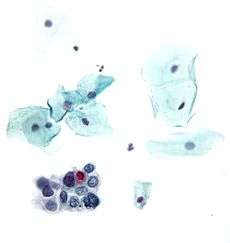Precancerous condition
| Precancerous condition | |
|---|---|
|
Micrograph of high grade squamous intraepithelial lesion, a precancerous condition of the uterine cervix. Pap stain. | |
| Classification and external resources | |
| MeSH | D011230 |
A precancerous condition or premalignant condition, sometimes called a potentially precancerous condition or potentially premalignant condition, is a state of disordered morphology of cells that is associated with an increased risk of cancer. If left untreated, these conditions may lead to cancer. Such conditions are usually either dysplasia or benign neoplasia (and the dividing line between those is sometimes blurry). Sometimes the term "precancer" is used to describe carcinoma in situ, which is a noninvasive cancer that has not progressed to an aggressive, invasive stage. Not all carcinoma in situ will progress to invasive disease.
Premalignant lesions are morphologically atypical tissue which appears abnormal under microscopic examination, and in which cancer is more likely to occur than in its apparently normal counterpart.
Examples of premalignant conditions include:
- actinic keratosis[1]
- Barrett's esophagus
- atrophic gastritis
- ductal carcinoma in situ
- dyskeratosis congenita
- sideropenic dysphagia
- lichen planus
- oral submucous fibrosis
- solar elastosis
- cervical dysplasia
- leukoplakia
- erythroplakia
The term was coined in 1875 by Romanian physician Victor Babeş.
References
- ↑ "Actinic Keratosis (A Precancerous Condition)". Retrieved 2009-03-03.
External links
| Look up premalignant or precancerous in Wiktionary, the free dictionary. |
| ||||||||||||||||||||||||||||||||||||
